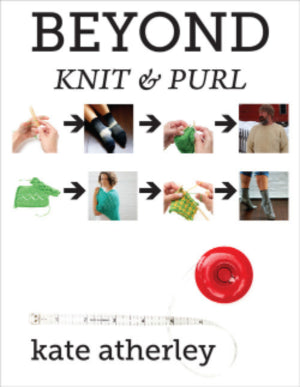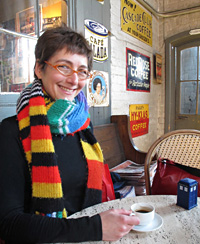I've been quiet here of late... been very busy with some technical editing. I am regularly blogging at the Knittyblog, as I hope you're aware?
The thing I've been most excited about from my discoveries for the Knittyblog is the Winchester School of Art Knitting Reference Library at the University of Southampton. (Go read the Knittyblog post for the background on this! It's very cool!) A selection of 19th century knitting manuals has been made available in PDF format for download - all fully legal.
I downloaded several - at first for sheer amusement value - I mean, honestly, how could I resist a booklet called "Ladies Work for Sailors". My perhaps slightly overactive imagination had fun trying to parse all the possible options.... were sailors expected to be doing work for ladies? Or the work of ladies? Or ladies doing work for sailors...
But once the amusement value wears off, these booklets are absolutely amazing treasure troves. They span 100 years of knitting history - from early 1800s to the early 1900s (whence my Sailor's work booklet came). There are stitch patterns galore, and instructions for all sorts of garments, fancy, fanciful and practical.
What's most interesting to me, as a technical editor, is the way the patterns are written. Some of them are more detailed, more precise, more easily followed than others... and it's interesting to see how standards of pattern writing shift over time.
The preface to the very first one reads... "Many practical patterns remain unused for the want of a few clear directions for working them."
Amen to that.
I spend a fair bit of my time working as a technical editor. I love this work, and it seems that it's just about the perfect occupation for me: I get to exercise my university degree in mathematics, I get to indulge my attention to detail, and I get to feed my need for consistency and style.
And really - that's what it's all about - making sure the directions are clear.
I'm a member of the technical editing team for Knitty, and have worked on a number of projects for Cooperative Press, including Silk Road Socks. My editorial role at A Needle Pulling Thread also includes technical editing responsibilities, and I've worked with several designers, too.
I've been asked more than once what a technical editor does, and why we're needed.
In short, technical editors make sure that a pattern works.
The first thing we do is to make sure the pattern is complete. Is there complete information on required materials - yarn, needles, notions, etc.? I just edited a pattern for a pillow cover, and in the materials list, it just said "pillow form" - but I know that pillow forms come in various sizes, so to help out the knitter I added information about the size required. Is there gauge info? Are there instructions for all pieces? (E.g. If it's a cardigan, are the instructions for all the pieces there?) Are the finishing instructions complete... ? And so forth.
And then we check the numbers. We check the stitch counts - making sure that math works.
And it's not just about confirming that the increase and decrease numbers are correct. We also check to make sure that the stitches given produce a piece of the expected size... and for a garment or item that comes in multiple sizes, we check the sizing. I ran into a sock pattern recently that proposed a foot circumference of 9 inches for a women's medium foot. The pattern was correct, but that isn't a reasonable size for a medium - that's a large or extra large, no question.
But I actually spend the most time thinking about readability.
I believe my experience in the IT industry,specifically as a technical writer, has provided invaluable perspective for this.
I tweeted a couple of weeks ago... "no matter how easy something is to knit, if the pattern isn't written to be beginner-friendly, then it doesn't qualify for "easy" rating". The instructions have to be clear, and they have to make sense, and they have to explain things at an appropriate level.
I have been known to get pretty worked up about this sort of thing...
For example, if your pattern says "Cast on 30 sts, work 12 rows in k2, p2 ribbing increasing 1 st in the middle of the last row", then that qualifies it as more difficult. It's easy to knit, yup, but that assumes a lot of knowledge on the part of the knitter.
It assumes you know how to work (k2, p2) ribbing; it assumes you are comfortable keeping track of rows, it assumes that you know how and where to increase. All well and good for a more experienced knitter, but not so good for beginners. And that "increasing 1 st at middle of last row" - well, that's not just about assumed knowledge, but it also supposes that the knitter will read ahead.
For it to be beginner friendly, it needs to say:
Row 1 (RS): *K2, p2; rep from * to last 2 sts, k2.
Row 2 (WS): *P2, k2; rep from * to last 2 sts, p2.
Repeat rows 1 & 2 four more times, and work row 1 once more.
Row 12 (WS): *P2, k2; rep from * 7 times, p1, m1, p1, *k2, p2; rep from * to end. 31 sts.
This is one of the reasons I love teaching - I am reminded every week about what beginners find easy to understand, and what's challenging for them!
Subscribe to:
Post Comments (Atom)






5 comments:
I believe I speak for many of us when I say how much a good technical editor is appreciated while I work through patterns! THANKS!
What a fantastic resource the Winchester School of Art has in its library - and I live only 20 miles away from there! This is the second reference I have read to the school, they also have a museum of all sorts of knitted garments (view by appointment). Something must be telling me to seek them out. I also found your explanation of what a technical editor does fascinating, thank you
Great post. How does someone with a background in technical writing and training (and knitting) become a technical editor for knitting publications?
this is a great post! as a "junior" tech editor, one of the first things I learned was to make some designers realize a simple thing: it's not because we both understand the pattern that knitters/customers will.. And this part is not easy at all!
I'm a beginning knitter, currently working on my second piece ever. Yet I'd find "Cast on 30 sts, work 12 rows in k2, p2 ribbing increasing 1 st in the middle of the last row" considerably *easier* to understand than the supposedly more beginner-friendly version you posted. True, the "increase in the middle" is evil, and I'd prefer a stitch count for the increase. But partial repeats? "Work row 1 once more"? For me, *these* make a pattern confusing.
Post a Comment